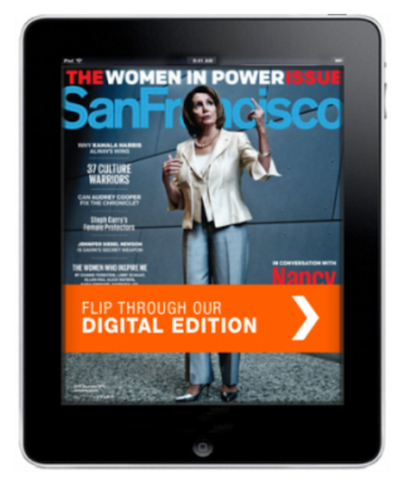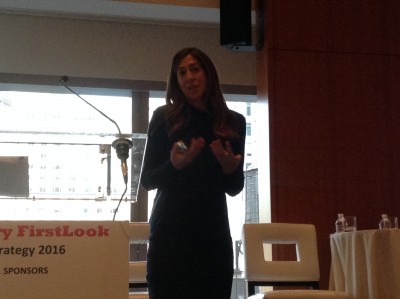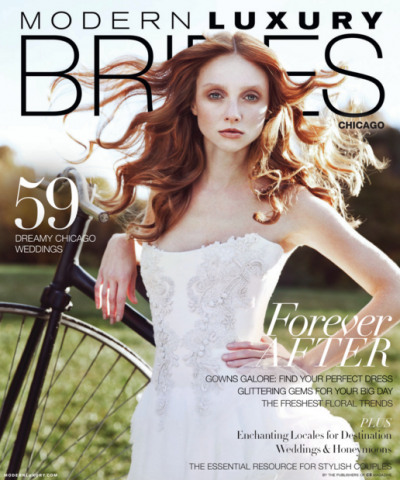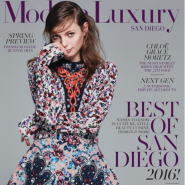NEW YORK – The key to reaching luxury consumers is understanding the nuances of the market, according to a senior executive from Modern Luxury who spoke at Luxury FirstLook: Strategy 2016.
By and large, luxury consumers are located in the United States, where more than $74 billion is spent on luxury goods, a number that exceeds the combined spending of Japan, Italy, France and China. However, those consumers are dispersed throughout the country, and the best way to entice them to buy is to appeal to market specifics rather than push products broadly.
“The U.S. represents the greatest population for luxury, and the best way to reach them is city-by-city,” said Marcy Bloom, senior vice president and group publisher for Modern Luxury. “Within them, it is imperative to know your best customers and your prospective customer – to actually, really know them.”
Luxury FirstLook: Strategy 2016 on Jan. 20 was organized by Luxury Daily.
Local hero
Luxury consumers, as with anybody else, have their lives defined in part by their families, their children's schools, the locations of their office, their favorite clubs and restaurants and the charity, art and sports events they attend. The best way to connect with those consumers is to meet them in those same places.
Individual communities have their own local celebrities around whom luxury lifestyles revolve. While Becca Cason Thrash may not be a household name around the country, the Vogue en Español founder and wife of eCorp CEO John Thrash is on every page of the society columns in Houston, TX.

Modern Luxury San Francisco
Every year she throws a party focused on women, wine and shoes that raises half a million dollars. Last year, Houston raised $12 billion for charity, and Ms. Cason Thrash was a major driver.
Other cities have their own local epicenters. Driving a distance away to Dallas, Pinnacle Group CEO Nina Vaca, named one of the Presidential Ambassadors for Global Entrepreneurship by President Obama, is the most connected, high-society local.
Modern Luxury, which operates nearly 70 publications in 19 markets, makes connections with local heroes by having an office and employees in every city in which it operates. Using these connections, the publisher can better understand the people on a specific, local level and thus market to them more effectively.
While some things are universal – between 80 and 90 percent of people are more likely to attend an event with a charity component – others are not. Recently, Modern Luxury worked with menswear brand Canali in Houston, donating to MD Anderson, a cancer research center.

Marcy Bloom speaking at Luxury FirstLook
As it turns out, however, consumers in Houston are more reluctant to buy expensive products in front of others. As a result, the promotion was extended through the weekend rather than being for the day only, as a similar event was in Dallas. This kind of localization could only be planned due to the sophisticated knowledge of the community the publication attained by having an office there.
Just as different communities have different local celebrities around whom high society revolves, different markets also have different events. In New York, the Met Gala is perhaps the largest event/party of the year, and in Dallas they have the Cattle Baron’s Ball. Although these events may be little known outside the market, they represent massive opportunities to connect with consumers.
While all markets agree – and all marketers might intuit – that Thursday is the best weekday for an after-work function, the preferred time varies by city. In New York, consumers prefer an event be timed at 7 p.m., while Chicagoans prefer 6 p.m. While markets all fall within that range, being close translates to less revenue than getting it right.
The attention to markets also extends into other details. Modern Luxury has found that having models on a cover increases sales compared to actors in Houston, Dallas and Atlanta, while the recent Art Basel event in Miami necessitated an entirely different cover for a publication in the market.

Modern Luxury Brides Chicago
In Chicago, a spread in the December issue played off the city’s inclement weather, but in the mild-wintered Miami, advertising winter clothes is far less effective. Likewise, while Rolex might advertise on the back cover of different Modern Luxury publications, the advertisement will be slightly different and the local retailer locations will be highlighted, thus telling consumers “where” in addition to “what” in a way that a nationally syndicated ad could not.
By researching individual markets rather than generalizing based on geography or country, marketers can learn small details that will help spur sales and provide an advantage over competitors.
Localization maven
It looks different in other sectors, but localization and a deep knowledge of a market will help all brands grow, not just print publications.
Global heterogeneity presents many obstacles for brands looking to maximize their share through localization efforts, according to a report from L2.
The share of ecommerce sales in the luxury industry has tripled since 2009 and is set to triple again by 2025, but obstacles such as currency, language, selection and payment method may make it difficult for brands to expand and capitalize on their reach. As social media, the Web and the development of BRIC, Asian nations and Sub-Saharan Africa in the future give brands more visibility, it is essential that they monetize global consumers (see story).
Although having dozens of publications may seem like a lot, Modern Luxury has no plans to slow down.
In the upcoming future Modern Luxury is expanding its regional coverage in the United States with a title dedicated to the lifestyle of Silicon Valley, CA’s affluent residents.
Modern Luxury currently publishes a title focusing on nearby San Francisco, but given the technology boom in neighboring Silicon Valley, a standalone magazine will likely be a welcome addition for affluents based there. Silicon Valley has seen an influx of wealth due to the technology brands that have sprouted in the area and employees that have settled nearby (see story).
“We believe that if there is affluence in the city we are either going to create a title or buy a title,” Ms. Bloom said. “We have bridal titles because bridal shopping is very personal and there is obviously tons of money around it.
“And for us we will grow not necessarily within a market that is a city,” she said. “We will grow in categories such as Bridal or Mens, as long as there is a population, you have the resources and there is demand."
{"ct":"W7Ayc+AixdQu9491yuvWrMnd\/e6SPlUI\/zW4HdrVFF8IuT5BuRih2yCMBMZUh6dbuOB5xitEei80cAnY4rQSgBToXegjjnb07CdtI1xAK0V90SxehM3koe8K\/LppP\/+Kv\/6PdJG8BTzB6ebwy3xzUX3nwwwWAuWZx72Hx3ipoYMJeUTgTWBGWha1E1LY4maneho7rRceDlSSKzMDmG8E5prsanJFmMTF+eSGOk9Gz326h6o5IifBFHHxj50\/UAObbQlv0Ci7YVsFJHpkFHee\/mWikb8KqHvpjdbLZaituwDx6WDq3RKgZU9n4va2XaRMeZurVwYhqiBQfn2k0iV6yI7ZXC4RmtTcJeRuYzJZgajK0Ar3kjRnimeXPmqX5fw+ikx8YdOGIe\/VWEUvUJiBNPM937B\/\/oPxQk5hgNvPDWqk9hv95rWkSjHz21IfhuVYh0F3KaLH9l0\/AHeMTEO1HHGUJtaDG\/etUsP9Piq+ALgPOOnXYqWrTAM1nZm1MHAYTCFqdAfYGqUdB56f89cc4i+D9lTJ61cDaenfOehLEpizqSVHayy3fVzF5D7Rf1KxKpMtv5R0AYj7g0sIy+Sbhh8HMIXTPYLwkR9tcPf9Nthce3jcPTAzvAgGchPir6hxKlfp6WdG3CPlr+dUuHDw9z3E37YD5k4lChiqgxCu2qZgOusR\/9pO3xB+L3niOSiwnkic\/Z51cUxIoj4IllxejaLu8uCWuSZcOtwU4LIZZO2C7I60jmMn613M\/Krnlzdk5Z0wg24KDQQd4Syj0yp+JQUdjWkCK89KbGX0ENoNcms7hsCgFoRZfFQKKZ9absDLR3euXNagRaY\/QJbwQo7bytZnac1igP85OoCiMczX40XlSZkuwvN6rXFpcC9WnzvPX6XmdVzKxvg12QgjOEuS2DNWukh\/nUMCACGN9FVd4Q0WLmBrVh+0xPSZ3mQEyCjERXE3GLl\/r4wKR39Nf7PuKdnYwTQg3UezrUYfgnuH3TNR15zD0+nicrSl2FXrWDoP990\/pSsfgMI84VxGYb8z1ZHja3lyE7F2ndbTOjnKqpSECblukFNaCHRlbxwi1QPGkKtI8jisdmkbXQ4y0+Bgj0zN+gryaMQ59o4JP\/yrZ5fN1ghkeTsPfjGgpBugDbu8SMx8smaNa5lwZ88R8VExK\/tLRUdZf\/jzAhJJdUUHi+37\/QRaG5tRZoEQiumZP8R717gDxGbt9WfBz021yhnHEmWrQirFpJlbU5\/V65DSVcmbqU8iWOWjw17RJm\/5XGbTKfFaKTPr8+NGblGrtVhUXBKSSDQHURZwKVDb28ApGxo+Z1TYf84NDbUJK7QbSqNtVOZrps0ZEaUnSnLWTQHsXADMx9DaXNioi+T7Raw1MKOlpq9G1IRYw1ahjj4tmdZJv4T6mXNn0dNyZprL6200aHQo0RzD4LIdH+7qiQS9NSbzrf3cXrTFU6At\/a65reCgKZjukVBwfnf5gt+HYl4VrC6NikrvAHT\/bRWorq2SfC56Kk6sxhpQZ5+QArqNNQGExiejKzzOYTkO\/S02GzoOMPlwuIdE7QwVw1izlRplUimNQUaCGR7y6BPiN1wofz8spz3pGhfocbndZv4O6kQLUk3hufhQdTowEYR4jjmAMFz5Xl0+UjogtpEO5k6CVjFDE\/fs\/hZOeSRzZfBEWQCzwdZl70iqoR4dAbLmYtMXtRu1m0QhU0fHghf50kWnnRx5CWdsfoKMIVSOVmtkMBXCjthIzazGOEsTUbjWDnzMUcY0K9tbycSQ3UpRbTBEbq4HQUw8Thgg7i9mdiXJF\/1v+tVLbo2CwR4lR\/TVGDTpBZDpsCnBfe0e0yz1YBYxCLFc0\/R832PWBVaJ3hCjPjGUDNNMPcFtvdPptAylNXIaGZ8xgxpvOxanso3uYrBWoxCv9R20wlPgENT0ELrWbh12kEagloGFM0u5EAf3avGLtg9C3rNac0lfuJNCt+1GiNBYBqdbdgSqczZULLbFtlpcEqMoFd92Of6ZjuZxK5doaerGDJr8WVAxqOOOx\/JPc+xtoA6Q416Uu7dM3Mq9dlyIvd\/PCD7N10oFQTI7YZmQsuTPbFqn+0exsU1FZKzcilp0Cj99M+d581itp9l2y8uVAF52V\/3Ne1ls3z5eHdLZXUEp163eSwXKS86\/4Tx\/G6azKKUktxQKumM9RZ1uGd9eLnZrIXLi+lBD+I6QUwFPSGMLakH9a5tS\/XGOTTXdUnE9ckvrMs1nITZVvLnL2Wan5Zx4GE1RuuPvUczn3EPSJup5La+xfsYyQIBxiiC1BdGnu56a4Ac+QTAeVOkWG17dzWvRUUB6l8AtfL4scHpmU+GjTPG9lnMIC9ft9u7\/DMcHVZ0nO3015NXRpxzE20sKohOVzryem2FnifNEBvWi38mc+PZNiUJgURg\/aQz4JkME2qEGbiZVvATSa+50H\/gwF8c3LvgRyTTU1JrP+RMwVwSJj1jO+RAyr1JSNseZyvXGATW9v0dT93z5BkjmIvzSk3mi7xhPF7E6AgIRiSCENlQNLLFkZuKvv\/Vtj5pRo1Y4ALk0s+narufCQybueGUfBS60YIH3wzxnwKDlWeFXEhCjKIYqib9ehajjPKdnn5Cov9WTH7zGUq\/7QI5kQ0eQeoHuuoUT8ZvEndSzGecUrHp51MKi6R5YvLIt\/BooJ1Pr4\/KrEz2KsRJl2VCmkLpTwu8HJpAzM7ZnYmoNwVBVgu16qdxMJs7AW2BG+2Pgot9Kv1JfVrn5rDGp3HSzEfLcDgQqtVHcjLrPH\/gDyLmnAShwIfQtXsbUaaJJABGhJjzv5+McztQ6z3wEt0XqTy1Ag6QWFuywmysQ3aY3OCjdLf4jauERIm3rWrURp0AnyrVrMVElcEh+Nsq04Nim3KSb7ynN8Nh4gjtM7E\/JjyvGhOgVEP8pitUO\/OYMlVxkGwPx8trZN4OIaTqxUzR\/olvAcI2NVQ9QUkfDXQBaBtsUjRwLHBHVYUPdzWKBDWRCHS+0IPUKHg9pBVo40i1CKK6+Vc0eaTAmQ+ue5e2KDbVra+Dbs2mJTUO7Tjc4jyMpkfF7Mlh3iNJgbeOAsbvyTOct+t98HHAcgKsIK\/ZsLwWYu2WgmGuSJij83W\/sLl1C3sXkV1VZUSd+4zCpThVvMJpedu2kW73YVD7mXPP0ISVaad4b2x29ckqWq8rabK4z9Wk4ccNxnP5bkuZAzLI4O2s3d6vJAdizHAJNOmoB31CXgCPFL0M9vxCuoLCpm2GDfdq1xLX89JLEW9vrX1yii0SQofdBO9rd46F3DmzBYHQVQ3reOJ8843e0\/7otvLBKh6ms0MsJNqyjpDvWDIbHg7uRUChPAFaZhVz12kf661jp0HkbJ2fFO2Fo3hIuzsiYId5L6W2pJtqOSLR2ZP28kAt9x9\/z6zvEKbYEei6Yezj+BFk3ihqAPvrl5OQkN0VAlPFyC0rvi1TQm7b8BQUAV2pClNVfy0KSTsZeMMy8OQ3vgcJEiS3wtXeGz8QvgD4tUHSaC6wTisRnZL2bS0e6zSqBFQoBMkPnBO1+WfmW26fZCReDI5qPzvhOpPkQZ2Jp1U7Pyp14cECQhQ7vhTd3FVRMZlv\/9FrJ6qIFtQQtBHSiyfx6vzEiUViUBhHV8gS1VYafsNpu8kwd\/1cW6wf2SKz\/sbCLHTibgFCguoAdroPAwDkAUeXGTzeNUeNYGq93hMsg5C3RvjFG6ZezVwyYk8chfDTA43Q+A50LK7bf3yHn6Z2dToUWdkXcs6G93xeuGCkPpZKFY8w5hz4wNwJpId\/IV4KgvCZ9mXAunQwMKZp0mHr9DrMI4IOcFLyORiqeS\/7LukXj4F3pqlaXKFX7pkq687NCg83rNWBuzmD6rkZ\/msk0\/MhZYlcQH\/EPygUsYRtXCjr5o+x8j90j0jXTXXgltHzVx1BqSceIDMpUUnYpWR7iESsG6kJXrMIXS2Lx\/M25UX0X4dLTEQf0INMZX4EWZjVcoYb0oQI+RqM9bzw\/snKEd0b0yg4ZWFhh6\/T752zebys3GacyClI8Onb899z9xOfMy4tjVKIVNrdzfsdhXbaxCj7IWnYcI8Z1FspEoGql8at2g\/uu\/\/dZnd+MzyjY\/3XlAEmyGMU\/6L019Mmyw18H4FI\/DcFAGNMYLBuDh6NKVgs11ya\/zM15QfhFlRCDc9e\/5zw0WSWbwm5OXIFmFJDonhGk\/yKwSxpFz\/fa+C+uTTb7Jum7i5fati29A7Gbm0YQK5RgtVhAFwoFDDImT5kOUtQm51klemjVtrM6y\/Ri8bTVomFczniR+sX0u1fpC43Fxbmcp6QxZU14OGFNyBUdsygy365RUrB1hvTG2yvnJUdCwKyPq38RlnhGCcfJVcvn4mLScp7JQ8yY7miBrN9c7wHMjQ6+cy0EELiA17tMznfWpzQrSVnUVyvKVEQGhps7m17\/+QgDlWfgQFB\/FrmVyTOm9xyZT2FTJaGqWcfIn6osnYBxp6aGzJaUcRCIiCSU\/kWLY4GkLi0EYwMV5cvrbAlhAYCWVKRoz39nJcnbqsgcz9MpHXYYKaan2PJT\/iWPD3iuVYsBfJwyGKhR+Jthogw1gLQoPEYVzoxX8DZmJzeZj1p62RzfxzTHJBV7PwSeWkSs\/UMUknEnLDWBxkRj67W83dTBgOTw0KjuzjhSBGXEVne0saTMywML4DGyBWl36yi\/MZPk+dvtVDNZZyNXguBp0ibUlYS3vohe3Q8HGMwHAEU18w7oc\/5yJtem7lwhBSN0RNEW1sMpJqr4qc5BBFSwOqQpl2O\/k1IrpjIlnXi\/90PWjWrmnoy6JYNAMzFJ5JKynWIW9Qq7ncKfvYg54PsW7OsWPPJ6tXGQOSSaPjwyuHcmyLNLfn0Zv+SSWb+bddOdVBacHgvi9LZDZ2T3UE7wNKaNi1jlLMMhJ7u8DdLVLfoQ5i9aaXgCFIALXLrNh96Udd3Yf3C5xVyJWsOV32i7JbUC+MXbIkwP\/itC29i5+Sf3UvzL2kXGMavmbzg22jiKur3IRN3xDlkV3NUyv6h2pXvWQ7WQR9\/Q1XeuTNpA1tAxNlRuuWdIf1xVE9Ua9BdVU0b4HX0+pf7CR6+ReOm7hT4Q3KJcD14QWyOYTEu9QRr+skMFvQRNxGmYB44pjUq3FFSiVdRUWCobDETtNBHQHIw79E4fjssPbpvzpSv\/YKEiqmX8nm9EYJm3S5knjAOCRzTbFUChcECxGcLG6CxwYWaoGrbaA+3i+H2nqc8wz\/uEmOQgmPFx2+vatFniQpZgFVDicNjJIlw5n8Bv4pK+HYQfRePFxc\/korZggnhL\/qud0it+5bntXVhYytdNm\/1OkYprnY1Wf4\/K\/DSGNXQYXkjq7YcgX2Ka2cK+QUDgMWNwl6mNM3nu1m0nK5xzzdnlD9eaBPMZrsSrC5LaqCKP7wfMfQvXY\/92xeI5sWoUSaVjNdvBrluK+zC5U2zydoCUf3PglG8yJD1JMtWdFaFcQhhaCpypyI+UE\/huDzWj9ZHGMrkqXsNs\/s3ybXHymk\/QSUoMFtlEEXME2hLUcNbLRZ+ETS+nUF198M\/DozHU5tySTdREiOhY3gAcBFzDHq+EEgqstR\/752IOGtVW93uxFPlOXZ9IR1WZl0SF1LwekGXArzD0yqooD8ufwqcYXzp6lu3K9dgXKACdhYswFC29Y8kHapRTS0edcULpMscYA\/icGePL4EoBL97yOtNF+rm92rQ4R61Bh6Jxfu43pqFkTcXkkkkgN\/Bhx0EoCPriBTiHTuqp\/1TkBEhE4WpL0BYheWzYhxGn9bqexmfsXwzlknB9MeXuVHZ2atj0C2lCA3\/BPLuIyt5Ek7cfAGsmw1jncFkgS0b3QMi7RBsW\/MhjLIgCYtR3kwDD7FGsRTQdevSnVVQ5NkkxBszu4ySb49sqkjoIF0vtGTaWEHYj8rdsAYTObtcbeMaKJi7jlk6LOp1Y82PDSXLki0GzCEev6Fw6ADSQzhYYt4poFExwIDkIdsnBZjCfvc6S7f08mDq3XLQzQ9iTG7i6AMRkJykCKXDrek5WBn2V2rnBuKZCiN9oXEtu3uqjoexVZUi+YRSlh3HBK\/75ub+jDce8IG5mQ8AXWjuZ0cebb1SrxRZzO6foQkQWjYtTODxkT2HbhZPTX6UExtcDrFQIFL27JRsbkG2Ext9MxTWeFwHg+bL5NejzFr2dK3CgF7MnU4bwKRqj5Pmp8iG5MZA1DzhjZinHW77kfJ99qUQPX6im5aCaJFLowl8yuG60nhigeWzlKp9yYarUlBzdH37aX28BbkRAvbSBEK+U6euxESU8fWFCkWnQTetICqCyxcPoiQpWBl\/bZHSY96enpHIM0aZxVEJOSJpSa3xPbA5abrXltU1Z3FlNgQX+H\/Xn+NRBEUjtKoqpvx208dBVKBahtaRvSm9JrQsS+029U3Htgqsbe8XJKHMnlX5qwN6SfdS8exizSNqy1Rpih85\/prEYjP\/1p0C+iVtVEgYDeGfezXL\/fDwpHNEM+jWJf\/wGKMYGVuYrVhKFRPl3qkj5eKJ\/OdBJDcuOOlbLiOrK5O4GhaQZgUFMZVjKCYcCQfSSKp\/Pr0kA\/ZCEjH\/H2eRQJJGhAKdbg5cbfAQaAIT1ZmqnVMhEYQq8R5BMQOhxVOCQOxro1fRGW2HudpeVmE0RYNMNK\/pWKwaH62+VwEmmOSVgbYW+vF9kSYPnJhBuythbfnhiycdA1JUM2BsDWt0klGt6dDxZnQ39c0W\/DhcQoMQvbnt1YBtYYgt2kde+JOPsgonZD5TEo30d5gddEzQzzEMzaanSbMdW2mMLPldHPpQhaZcKeEq2br72t3l+hVr+RfeGtEmvpEpDavrzrpKHKM1G3kZwDj+xMpTdTndv8jWaJAL+FnTLf7YVs\/0upfnATcOQS+4o1+j14BGDO0Rg8xwTo2VEhqBR5tzJpgvKZH7BZ8wxQuOIPdZPwKv5Z5hT8fN6yj3usywCDW0W2jKecfyBfXLqkslPdLh2GOBREEgnjRZ8XmN0Ku7s\/dMOhfvYrbp2ikN+pc1kACBLZSW8AhnSoMX9bysWs\/KjGGfeAahHLZAeOlnQwdwwHdJYf+TbWGWXhptlkc2hfq+cV0t1NSx+zReVkpaf108u+Ds+yUNpZ19gOEcKw9W4\/GxDszQDYHRSrtB\/48wUpLyf+aOYlcNkeX+SDbjsLwrMWoBs6xUgM9kVytqBPUyQ2gL1yOPbAKs0ozjKUxWpUTSU3nrwFgwvrobJrM4AaDI3p7BjvrWsEd+NDGzJTBvNL3pxV7FqC0aYP6P7\/zlwxv2gSnkEDwvHE5DcNlhX1zH6yy9na9hZX9X5r4oDsh7bzmmhlQSvUvcNfN4cpGLeApZlD7vlvZI4b5Ab6ZGEAkgAP272KqdJJJg5EjUAgNKaVsNWZbSw1WNhbTp+8OcmxLIqUyG2UqbE3FoLas7bGibzNSks8p9MxVGQ+tLI9MabVgvfs2aG\/Bwn6BxEo8DA3yMuJ1bVz8lCd7zj1BNvU1RIA81yqggjbBe19UMtG8DQs1A5+aUpQSXvvQGdFnE7RwXMlQV5KmxE2ravsaal4V1n3KPngNJbsmlVVJtsBCWtCSpB701DjnALXI\/MS\/6LpR9+P5aagKV5cqkM4JCm1AxoXG4RzmpQGO51TC5pzQjy8oH7bGaaSOTGovi1wa0diK1zSfxZ7LjC56Wb9XLxXCXEvUOKc\/pa96qg0HgXEhJZssBH7tulTnXBz9x+zvjV6nfGtmSJIeX8mKrrkXwiA9ZPDdZI47HvyCZZSPCeacTxJrKAPP8ad2eZhHs817qRhOhkZ0JL0PM6EghGW\/6RPLIUnZeNFntgpcXVrynRhzQfRjXaCVHyO8Dk1pMKL0JAzi0GAaMFhHKJ3vtjz4rZhNz7C5V65CWudSj6jqu6augcqCYqtOmhLBqWPQXNTZb\/bnXnDYBUM7Wr3vE6Jf2vzZUSxm2LgXB07UkXtL8yMQk4z4dRnyyNmt8nocfdXf8JF9Fq2o2eVwIoCzFviV3nsc6jcmchUbiP+cRTHjcNJLPA\/5Ks7wEQut+TZX7zXaWH\/htHgLOVP9Dx7N1LonqxYeS9YVGlOrEMk2u1jBVbJuy986upmohhDBYFtM+5v5XkbC+hvJmbf19pJEcE1zEY\/4H6vbnB5DDZR3GAIhhxeOVnwIiXkq4c593YfnsvDy7wnsZCCbYUfam2fN\/IyIcd1EYZt2+PodbpndiqzIgpfX34UHu20h5\/3vkIH0pfoheU+\/+lZIYbFJh\/chs0vacYX+j05Fw7Yojaz0TZTbjs3qpr0Pbgxzhyn4XATHKPK2grbZunfpqq577AR36Bu3fNA6Cg8vex0QPNCjF6hfD70ioemFD2h8awtJs\/JhiwWkse1eRQkFClHF5JYSMqqsNENGNBTtWpTc0Ca+jbp5WRF43I4eD1H0rH0+44BZ0fx3nnspOlWhKStjupOQAWt3vgxMfpH7LwG8vtm7iVkIX3189HCJOISO1IClJbAxYB+YJALiudhZH5ztu97SiKFmtHw2PU0\/aJwxF8ujAquoMXXEYV1Li7Es4r4Lmp3mkwxiiaPU5JmA6n8+1Y3+cf4uTEoUhuYfZ3bAbmPV+BpC8r3U6Fg2OrkZ3x5MyhUqAyAwMAA20zkElTMasEaZY5SJHh8Qxh8KQlEvei4QgXVvnlwWfe2FogZzQUUdM7qs+NC0IK96Bh\/kwGxuYmN4vpTkt5HpHv\/9xzJlr0+k+Xh4yMuj+2Lvow88+8xNjJbPO81NUBoSbgnWZZZd7+Lims3YMdVFmghCn+tsUXJV4CghqnpVuCesfmmNcJoY7iy3Ek3EZl4o8E2buAtxd8wc8fs6jxG6NgxlnSdo0B0qqhjyHLxDT0pNubLOUgit1\/cuBaunzkADZzo\/wyO6AYVdc1o1xwp04ykfeHB6Be\/\/CqeXM7AwOpr2kpWjImax9uGang6vN9J35UAUIvxgPp8yOWpcNZHUA849QTh6ZVQ5bRXcroEE9v19CPXk2YKPxJb8qsCUKWqRsIOsxGA41zFknkXDZ4j3UltSRbjOq2X\/+SRWSsMR91sMuYh9d2RcLbNJi0PumkgchFZZjg3l+PDzcf\/mVgMR9ze2McuL\/5gbaO797nowMnQCMDVjymOfJjZLrt4oTtK6L9NtNEORzgQgnxoySsMqLUdif4UQsfEV4FAbDM1ig+NMkXeQPsdef+IBQIbCU\/LtC6Zwn+fH7c3g\/9E68wc7gXWjQW\/DAIRcaunM0GSFNHYB0HGiEewPvS38Zc9wvuoFY6BDnplo85\/63ToA0ovMyh8LqMzKpc+pXU3An8uSizSai7cbR3IBjQKLasTjcJB5Rk6SSF6Pflz19zWZ24c+mDw90xd85Q57BxxkFCUTimmkW2JoASBBcIaavzH6MFyA1sLvVw69p8O2HCAZcvZA9eWshcuW01OXjw0lCftZrFW7Da9L9ONb\/lfGJnAa\/UmYDFgQHY+JuubauGk1LpUOl9uITlEylSC4dNCPcdw+DLh\/NRb6OhCfVM\/Idvf8IWK8Qc4MeJ31DFecIoQKgaxIvVcrvATigZY6Hk7zzJek7J95z0jtDZB1nrUOIwURRN11+83gz1sptShMUacfLPGMEx9b+K1ZS3+98W49ERoQ8em741puzhezkB7mvQ8aRXvQMkzmH9M5\/ig1twpoO09Z60\/rbw7BkbXA8jEy1fhNh3GwNNtpGtqsAkSkRteNa+8b2J+3\/qmIX4f9FpRHVyLyt2N2McbcS+gxIPdj5heiLJIx2rgdnXW7sDo+NwO+XnRTEgyqKKC3RBf49XuQ9ZzJ3sdV14rmY6zrIzALXc9Q6Iv3ybGdJx3OVBoU5YxwbU4jCcq6Dc5UoebQUC5YvW4I2gUkPJB4hTAZXc0SFGx3EoMPAFn2mDJnfN2aIxVcn3LMENJn7Y3bHdrlr9aTsLzDho5DSulLIpC\/reRa+iPULZhBiXmtjzYuIeWClqsBARaOoGczUL2TxPYzPEhTN+v1wb980EyH2gdACQ+mOLkXKT6mnssO9zAhhX47At7kz30z1luleWsLbzNzJh0WsIX5up0I7wwOnHabbJJ+oG17VwSN6uKNZpI9Z13hDboT2MJWvW7NHs3aLl9\/Xcw5\/QoKLjRtZid7u6fMhpD9lJDib6ZwUEm\/K8fDSy1jA+klCH4ZtbtFDGTvXtpp8TqbjSf4GqofoYRQjPiqoKm+JmiReZCJw3+\/Uqm2KY7cbAbeHo8CkQRSRBtQ69qSkVd7CkEKtYROIu\/Xre1VlEFJhm0rMxGWM5WA6A6yL9\/qcw\/IBswMmoryLmWljTHrAfgdvn7p7+anf1n9nyaZNQP6uCqshSUJI+q61hbhNOX7Xywf3X0+r\/RBLNudADHjRewsk6B95oE0FHM6HZiTAosiHzPQe3+jfptcmeqY3ZBIFhTLH624EflS8wkHRvHOCSxtdn4MFXQeZ6cWoJcNaXgh\/s08eaP5BgoNDHs14eoOc1Dtfrw2hSbQZUd0Ws59BmFKIuzDFaXgpfCwGnVWMygdBXo9w11tUrpZqBtsfb+Z679O\/k38FOGCCDxiAbBeob9sVpcQCbTbp8FSWGh1FrpCT0CUzPBF5\/ym+5Awjk+qe9GCzjEe6qfwAuzGtPOGk4fk+gziOO7S0xBDiguP1abMdZjeMUZP1H6uIJCpyADdNnYmv9hOG2HUpHBYFBQrAia+B+Hga+zc+1xuagS6sHGV08HDjO2AvOTGi4RP\/6MawyyHgjPaqq6\/hDQghIS7VmG0fT1c8SfqtxS8teYoiWgeRZfWqP1A8RuNFFr9LrzG+icQIRyrlA5e6ZEc6mRjB2g67VAG8uUeHammxiMvno3hewzGs0PfMYUGSl2vMi8BSbT\/zH3tGuz37NjQSaiy2QqtpgwKlHKZOVGItk+YclJ4zLM32T8cdZrWfYxyCI6Pbi+IWfHrr9AZG3q\/vZj760X9quzyKQuuXWYY6Xl3O8qPILkCLqlfqwYuNMQzWar5hi4Tmu7hJOhE5su0yDhxOh3idcLrHKYb2MTnOnHKkv42wl7lFEtZKweaZvefOLJSATz1wTerekKD0G62ebFlyDmR3PhhJnoBEgOK3JJiTQ+eAYSvLWhM5Cwza4ud+kzLKs7EgwJyoMaRDm\/FRQ7dXoiltGmu9DyBjuSwbEr\/1bR5rtiv64umByLNVcF7uGivqObdPp+CpXJgVxrzV8fXCuKkeWwaH2gk1iMSeZ9tX9\/X3wYRcFYglbtu\/vPdL+WscmIy9YhdTis8ixy5PX47WvuLxlGmHb5AJCtYnYE82ALrqQN8n3\/jmjZPX06gkp9oNhbwVVana62mlVCHso4LdkLim\/wcMbi9O9dHq\/m3RjqTt3IXQj71AgD0QcBq1cfhspHje4ujaFGvlykNVmE2G4095cxn\/X7KX+TIR498X5pnBEhU1gvmhIA+7+wiYYTWcTo1YYUzbMXuQXiqAuRrTnMA==","iv":"a5847162f7fcef5781b867724d4849e1","s":"260a85518fe8cb0a"}
